White_widow
technology theorist
- Joined
- Oct 25, 2010
- Messages
- 1,198
- Reaction score
- 3
- Points
- 31
Not going to lie, right off the bat, noone has a down pat spiderman webshooter or the formula, but I've got tons of ideas and I've seen that you guys do too. I'm going to post all of my previous entries and add more. If anyone wants to join in, that would be pretty cool. I'm no engineer but I'm a fan of chemistry. Let's do it guys!
Nolder posted this:This purpose of this post is to clarify where we are with the project. We will probably have increased traffic due to the release of the movie (at the time of this posting there are 9 guests viewing this thread ). This was the first thread I came to, as it was the first result when I googled "how to make spiderman web shooters".
Hi! Welcome to the forum! We are a group of people with a common goal of creating functional (not movie prop replicas) web shooters based on those worn by the fictional hero Spider-Man (though you probably already new that). If you have an understanding of chemistry or you're good with small pressurized devices (BB guns, paintball guns, etc), we invite you to create an account and share your ideas with us. If you don't, you can also create an account as we appreciate words of encouragement.
Though everyone has different goals for their web shooter, this is very much a team effort. If you have a question someone is bound to help you. If you have an idea you want an opinion on, you will get many opinions on it.
The following are links to the two main threads regarding the web shooter and a link to our website.
For the creation of the webbing, go here:
http://forums.superherohype.com/showthread.php?t=351889
For construction of the web shooter itself, go here:
http://forums.superherohype.com/showthread.php?t=385775
Our website:
http://realwebtech.webs.com/
If you are feeling adventurous and want to explore old threads, you can find them here:
http://forums.superherohype.com/forumdisplay.php?f=30
Good luck everyone and welcome!
Also, this forum isn't worth anything anymore.
Nolder posted this:This purpose of this post is to clarify where we are with the project. We will probably have increased traffic due to the release of the movie (at the time of this posting there are 9 guests viewing this thread ). This was the first thread I came to, as it was the first result when I googled "how to make spiderman web shooters".
Hi! Welcome to the forum! We are a group of people with a common goal of creating functional (not movie prop replicas) web shooters based on those worn by the fictional hero Spider-Man (though you probably already new that). If you have an understanding of chemistry or you're good with small pressurized devices (BB guns, paintball guns, etc), we invite you to create an account and share your ideas with us. If you don't, you can also create an account as we appreciate words of encouragement.
Though everyone has different goals for their web shooter, this is very much a team effort. If you have a question someone is bound to help you. If you have an idea you want an opinion on, you will get many opinions on it.
The following are links to the two main threads regarding the web shooter and a link to our website.
For the creation of the webbing, go here:
http://forums.superherohype.com/showthread.php?t=351889
For construction of the web shooter itself, go here:
http://forums.superherohype.com/showthread.php?t=385775
Our website:
http://realwebtech.webs.com/
If you are feeling adventurous and want to explore old threads, you can find them here:
http://forums.superherohype.com/forumdisplay.php?f=30
Good luck everyone and welcome!
Also, this forum isn't worth anything anymore.
Last edited:








